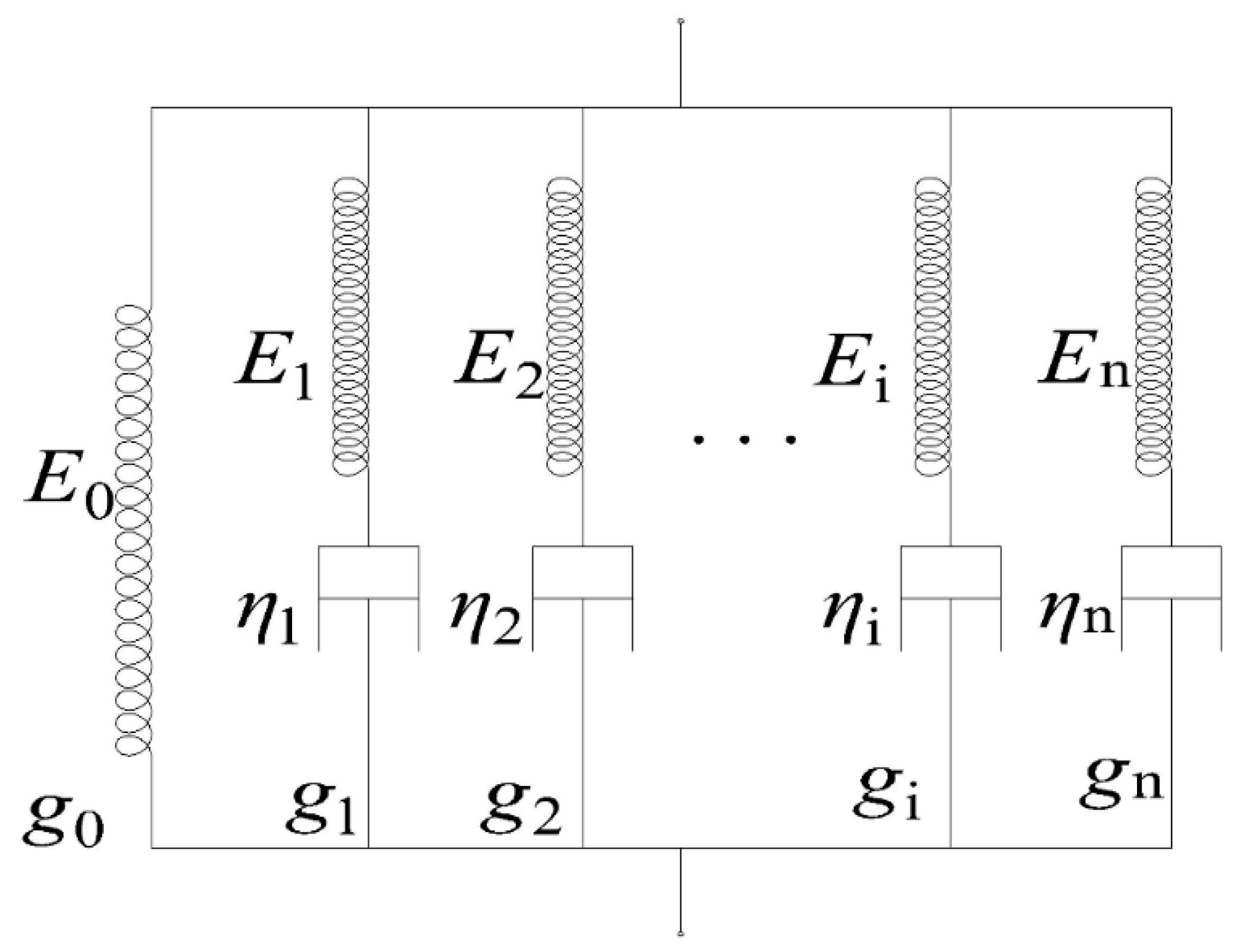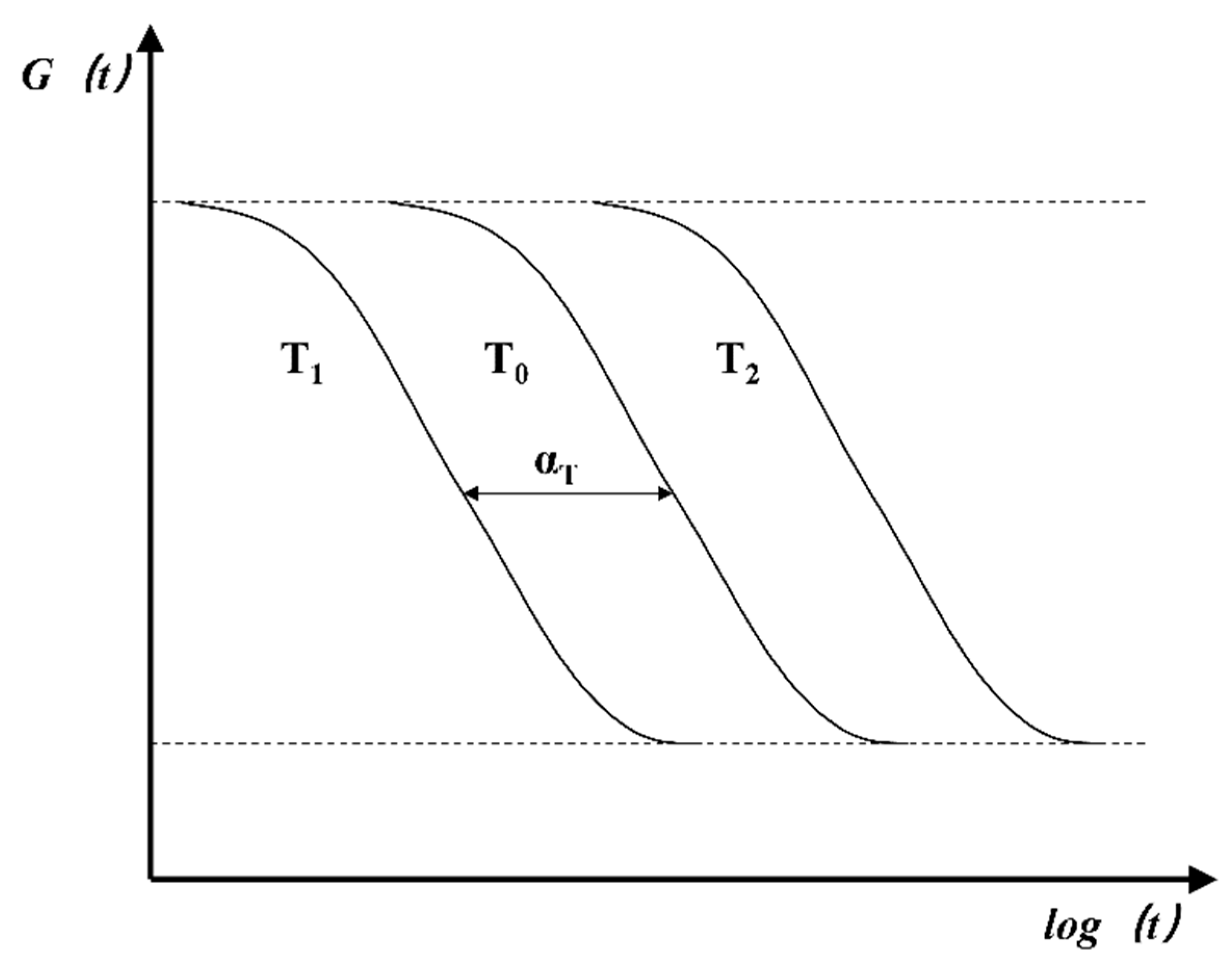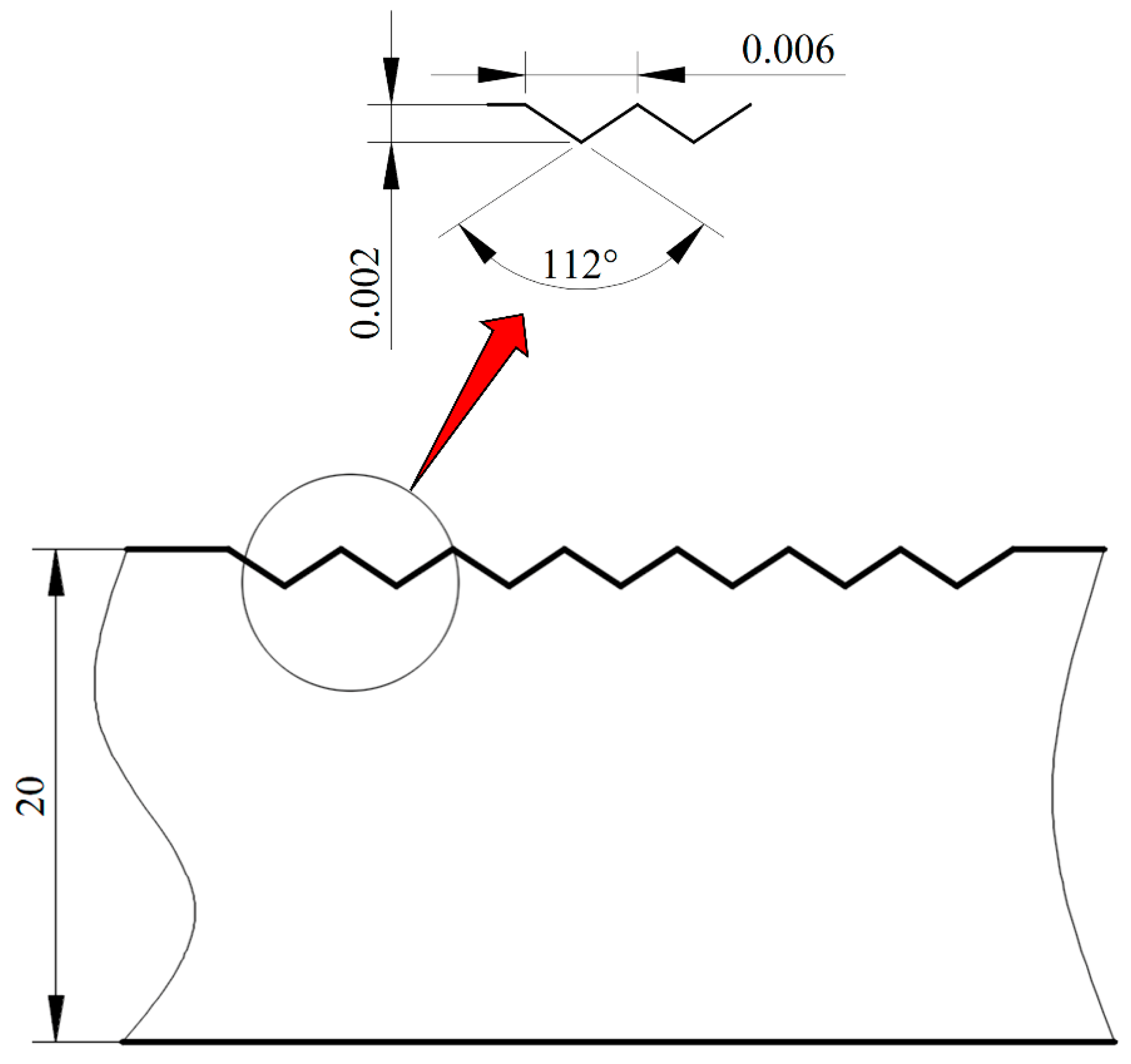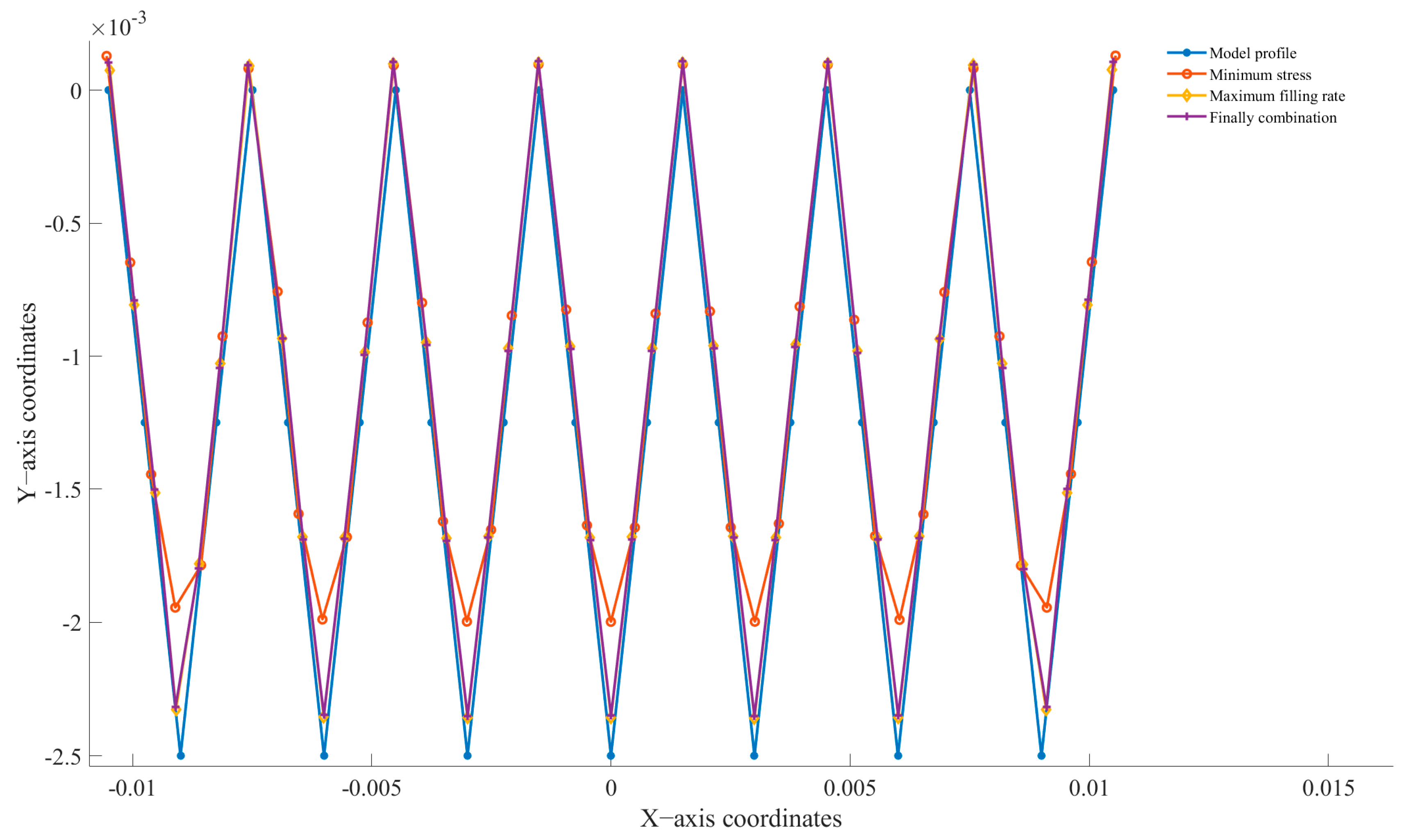Mechanism Study of Ultrasonic Vibration-Assisted Microgroove Forming of Precise Hot-Pressed Optical Glass
Abstract
1. Introduction
2. Theoretical Study
2.1. Glass Viscoelastic Material Model
2.2. Glass Thermal Rheology Model
3. Simulation Analysis
3.1. Optimal Combination Process Parameters without Ultrasonic Based on Orthogonal Experimental Method
3.2. Influence of Ultrasonic Assistance on Surface Forming
3.3. Influence of Ultrasonic Parameters on Surface Forming
4. Conclusions
- (1)
- The simulation results obtained by the optimal parameter combination show that the maximum stress of the glass is 1.648 Mpa, and the filling rate reaches 97.11919%. The result is better than any combination of parameters in the orthogonal experiment, and the combination obtained by the orthogonal experiment is indeed the best.
- (2)
- The average deformation displacement of the glass reaches 1947.561 nm, and the maximum filling rate is 97.37118%, while the glass is in the forming process. The average maximum stress during hot pressing is only 1.04 × 10−4 Mpa, which is a significant reduction in stress compared to the optimal combination of parameters in the orthogonal experiments. The results showed that the stress of the glass is greatly reduced with the help of ultrasonic vibration. In addition, the glass-filling rate was also better than that without the ultrasonic situation.
- (3)
- The thermal effect of ultrasonic vibration creates a softening effect in the glass, where the stiffness (resistance to deformation) of the glass is greatly reduced, allowing the glass to deform more under the same molding conditions.
- (4)
- In addition, the mechanical effect of ultrasonic vibration enhances the fluidity of the glass in the viscoelastic state, and the distribution of the glass on the mold is more uniform, which not only improves the stress distribution of the glass and reduces the stress of the glass, but also makes the molding effect better, and the filling rate in the V-groove is higher. That is to say, the surface shape of the final product fits better with the shape of the mold.
- (5)
- As shown in Table 5, in the ultrasonic sensitivity analysis with different frequency, amplitude, and loading time, it is found that the ultrasonic loading time has the greatest influence on the glass-forming stress.
Author Contributions
Funding
Conflicts of Interest
References
- Hossain, M.; Gu, M. Fabrication methods of 3D periodic metallic nano/microstructures for photonics applications. Laser Photon- Rev. 2013, 8, 233–249. [Google Scholar] [CrossRef]
- Kotz, F.; Quick, A.S.; Risch, P.; Martin, T.; Hoose, T.; Thiel, M.; Helmer, D.; Rapp, B.E. Two-Photon Polymerization of Nanocomposites for the Fabrication of Transparent Fused Silica Glass Microstructures. Adv. Mater. 2021, 33, e2006341. [Google Scholar] [CrossRef]
- Bernardeschi, I.; Ilyas, M.; Beccai, L. A Review on Active 3D Microstructures via Direct Laser Lithography. Adv. Intell. Syst. 2021, 3, 2100051. [Google Scholar] [CrossRef]
- Ming, W.; Chen, Z.; Du, J.; Zhang, Z.; Zhang, G.; He, W.; Ma, J.; Shen, F. A comprehensive review of theory and technology of glass molding process. Int. J. Adv. Manuf. Technol. 2020, 107, 2671–2706. [Google Scholar] [CrossRef]
- Zhou, T.; Liu, X.; Liang, Z.; Liu, Y.; Xie, J.; Wang, X. Recent advancements in optical microstructure fabrication through glass molding process. Front. Mech. Eng. 2017, 12, 46–65. [Google Scholar] [CrossRef]
- Butkutė, A.; Jonušauskas, L. 3D Manufacturing of Glass Microstructures Using Femtosecond Laser. Micromachines 2021, 12, 499. [Google Scholar] [CrossRef] [PubMed]
- Xie, J.; Zhou, T.; Liu, Y.; Kuriyagawa, T.; Wang, X. Mechanism study on microgroove forming by ultrasonic vibration assisted hot pressing. Precis. Eng. 2016, 46, 270–277. [Google Scholar] [CrossRef]
- Bolotov, S.; Kobayashi, R.; Shimada, K.; Mizutani, M.; Kuriyagawa, T. Fabrication of Precision Micrograting on Resin Substrate Utilizing Ultrasonic-Assisted Molding. Int. J. Autom. Technol. 2015, 9, 43–50. [Google Scholar] [CrossRef]
- Zhang, L.; Liu, W. Precision glass molding: Toward an optimal fabrication of optical lenses. Front. Mech. Eng. 2016, 12, 3–17. [Google Scholar] [CrossRef]
- Zhang, L.; Naples, N.J.; Zhou, W.; Yi, A.Y. Fabrication of infrared hexagonal microlens array by novel diamond turning method and precision glass molding. J. Micromech. Microeng. 2019, 29, 065004. [Google Scholar] [CrossRef]
- Yu, J.; Luo, H.; Nguyen, T.V.; Lu, Y.; Huang, L.; Zhang, Y. Mechanism study on microformability of optical glass in ultrasonic-assisted molding process. Int. J. Appl. Glas. Sci. 2018, 10, 103–114. [Google Scholar] [CrossRef]
- Chen, Y.; Feng, X.; Xin, G. Experimental Study on Ultrasonic Vibration-Assisted WECDM of Glass Microstructures with a High Aspect Ratio. Micromachines 2021, 12, 125. [Google Scholar] [CrossRef] [PubMed]
- Yang, Y.-J.; Huang, C.-C.; Tao, J. Application of ultrasonic-assisted injection molding for improving melt flowing and floating fibers. J. Polym. Eng. 2015, 36, 119–128. [Google Scholar] [CrossRef]
- Dudowicz, J.; Douglas, J.F.; Freed, K.F. The meaning of the “universal” WLF parameters of glass-forming polymer liquids. J. Chem. Phys. 2015, 142, 014905. [Google Scholar] [CrossRef] [PubMed]
- Chang, C.-Y.; Yu, C.-H. A basic experimental study of ultrasonic assisted hot embossing process for rapid fabrication of microlens arrays. J. Micromech. Microeng. 2015, 25, 025010. [Google Scholar] [CrossRef]
- Luo, H.; Yu, J.; Lou, H.; Huang, K.; Hu, J.; Xu, B. Thermal/tribological effects of superimposed ultrasonic vibration on viscoelastic responses and mold-filling capacity of optical glass: A comparative study. Ultrasonics 2020, 108, 106234. [Google Scholar] [CrossRef] [PubMed]
- Alers, G.A. Ultrasonic Attenuation in Zinc Single Crystals While Undergoing Plastic Deformation. Phys. Rev. 1955, 97, 863–869. [Google Scholar] [CrossRef]
- Blaha, F.; Langenecker, B. Plastizitätsuntersuchungen von metallkristallen in ultraschallfeld. Acta Met. 1959, 7, 93–100. [Google Scholar] [CrossRef]
- Tsai, Y.-P.; Hung, J.-C.; Yin, L.-C.; Hung, C. Ultrasonic vibration-assisted optical glass hot embossing process. Int. J. Adv. Manuf. Technol. 2011, 60, 1207–1213. [Google Scholar] [CrossRef]
- Xie, J.Q.; Zhou, T.F.; Liu, Y.; Kuriyagawa, T.; Bin Wang, X. The Effects of Ultrasonic Vibration in Hot Pressing for Microgrooves. Mater. Sci. Forum 2016, 861, 121–126. [Google Scholar] [CrossRef]
- Hung, J.-C.; Tsai, Y.-P.; Hung, C. Development of a new apparatus for ultrasonic vibration-assisted glass hot embossing process. Precis. Eng. 2012, 37, 222–227. [Google Scholar] [CrossRef]
- Nguyen, L.P.; Hao, K.-C.; Su, Y.-H.; Hung, C. Modeling the Embossing Stage of the Ultrasonic-Vibration-Assisted Hot Glass Embossing Process. Int. J. Appl. Glas. Sci. 2014, 6, 172–181. [Google Scholar] [CrossRef]
- Suzuki, H.; Hamada, S.; Okino, T.; Kondo, M.; Yamagata, Y.; Higuchi, T. Ultraprecision finishing of micro-aspheric surface by ultrasonic two-axis vibration assisted polishing. CIRP Ann. 2010, 59, 347–350. [Google Scholar] [CrossRef]
- Gao, S.; Qiu, Z.; Ouyang, J. The Improvement Effect and Mechanism of Longitudinal Ultrasonic Vibration on the Injection Molding Quality of a Polymeric Micro-Needle Array. Polymers 2019, 11, 151. [Google Scholar] [CrossRef]
- Park, D.S.; Cho, M.W.; Lee, H.; Cho, W.S. Micro-grooving of glass using micro-abrasive jet machining. J. Mater. Process. Technol. 2004, 146, 234–240. [Google Scholar] [CrossRef]
- Zhou, T.; Xie, J.; Yan, J.; Tsunemoto, K.; Wang, X. Improvement of glass formability in ultrasonic vibration assisted molding process. Int. J. Precis. Eng. Manuf. 2017, 18, 57–62. [Google Scholar] [CrossRef]
- Nguyen, L.; Wu, M.-H.; Hung, C. Finite element analysis of ultrasonic vibration-assisted microstructure hot glass embossing process. Aust. J. Mech. Eng. 2017, 17, 199–208. [Google Scholar] [CrossRef]
- Eaves, A.; Smith, A.; Waterhouse, W.; Sansome, D. Review of the application of ultrasonic vibrations to deforming metals. Ultrasonics 1975, 13, 162–170. [Google Scholar] [CrossRef]
- Arai, M.; Kato, Y.; Kodera, T. Characterization of the Thermo-Viscoelastic Property of Glass and Numerical Simulation of the Press Molding of Glass Lens. J. Therm. Stress 2009, 32, 1235–1255. [Google Scholar] [CrossRef]
- Zhang, M.; Chen, Y.; Wei, D.; Dai, L.H. Extraordinary creep relaxation time in a La-based metallic glass. J. Mater. Sci. 2017, 53, 2956–2964. [Google Scholar] [CrossRef]
- Zhou, T.; Yan, J.; Masuda, J.; Kuriyagawa, T. Investigation on the viscoelasticity of optical glass in ultraprecision lens molding process. J. Mater. Process. Technol. 2009, 209, 4484–4489. [Google Scholar] [CrossRef]
- Zhu, Y.; Na, J.; Wang, Y.; Li, A.; Zhi, Y.; Fan, Y. FEM analysis of hot-pressing process of aspheric glass P-SK57 lens. Opt. Manuf. Test. X 2013, 8838, 259–264. [Google Scholar] [CrossRef]
- Sun, S.; Li, K.; Chu, W.; Gong, F. Tungsten carbide molds for precision glass molding process: Mechanism of high-temperature degradation. Int. J. Refract. Met. Hard Mater. 2022, 105, 105841. [Google Scholar] [CrossRef]








| Material Attribute | Tungsten Carbide Mold | P-SK57 Glass |
|---|---|---|
| Young’s modulus of elasticity E (GPA) | 710 | 93 |
| Poisson’s ratio ν | 0.22 | 0.249 |
| Density ρ (kg/m3) | 14,650 | 3010 |
| Thermal conductivity Kc (w/m. °C) | 63 | 1.1 |
| Specific heat capacity Cp (j/kg·°C) | 314 | 760 |
| Coefficient of thermal expansion (/°C) | 4.9 × 10−6 | 5 × 10−6 |
| Conversion temperature (°C) | - | 494 |
| Factor Name | Heating Temperature (°C) | Pressing Displacement (mm) | Hot-Pressing Time (s) | Holding Time (s) | Primary Cooling Time (s) | Secondary Cooling Time (s) | Friction Coefficient of Lower Mold |
|---|---|---|---|---|---|---|---|
| Level 1 | 580 | 0.008 | 350 | 200 | 200 | 80 | 0.15 |
| Level 2 | 590 | 0.01 | 400 | 250 | 250 | 90 | 0.17 |
| Level 3 | 600 | 0.012 | 450 | 300 | 300 | 100 | 0.19 |
| Factor | Heating Temperature (°C) | Pressing Displacement (mm) | Hot-Pressing Time (s) | Holding Time (s) | Primary Cooling Time (s) | Secondary Cooling Time (s) | Friction Coefficient of Lower Mold |
|---|---|---|---|---|---|---|---|
| K1 | 10,549.5973 | 9471.731 | 10,553.4702 | 10,553.0023 | 10,552.4242 | 10,552.5476 | 10,551.0993 |
| K2 | 10,553.9958 | 10,536.054 | 10,554.4337 | 10,554.2177 | 10,553.1137 | 10,553.0033 | 10,555.6882 |
| K3 | 10,556.2817 | 11,652.0898 | 10,551.9709 | 10,552.6593 | 10,554.2784 | 10,554.3284 | 10,553.0873 |
| 1758.266 | 1578.622 | 1758.912 | 1758.834 | 1758.748 | 1758.758 | 1758.517 | |
| 1759 | 1756.009 | 1759.072 | 1759.036 | 1758.852 | 1758.834 | 1759.281 | |
| 1759.38 | 1942.016 | 1758.662 | 1758.777 | 1759.046 | 1759.055 | 1758.848 | |
| Range R | 1.114 | 363.394 | 0.41 | 0.259 | 0.298 | 0.297 | 0.764 |
| Sensitivity | Pressing displacement > heating temperature > friction coefficient of lower mold > hot-pressing time > primary cooling time > secondary cooling time > holding time | ||||||
| Factor Name | Frequency (Hz) | Amplitude (μm) | Loading Time (s) |
|---|---|---|---|
| Level 1 | 20,000 | 1 | 200 |
| Level 2 | 25,000 | 2 | 300 |
| Level 3 | 30,000 | 5 | 400 |
| Factor | Frequency (Hz) | Amplitude (nm) | Loading Time (s) |
|---|---|---|---|
| K1 | 893.4145 | 893.8931 | 1674.317 |
| K2 | 893.8633 | 893.4341 | 984.684 |
| K3 | 893.9441 | 893.7873 | 577.08 |
| K4 | 893.6181 | 893.7255 | 338.759 |
| 223.354 | 223.473 | 418.579 | |
| 223.466 | 223.359 | 246.171 | |
| 223.486 | 223.447 | 144.27 | |
| 223.405 | 223.431 | 84.69 | |
| Range R | 0.132 | 0.114 | 333.889 |
| Sensitivity | Loading time > frequency > amplitude | ||
Disclaimer/Publisher’s Note: The statements, opinions and data contained in all publications are solely those of the individual author(s) and contributor(s) and not of MDPI and/or the editor(s). MDPI and/or the editor(s) disclaim responsibility for any injury to people or property resulting from any ideas, methods, instructions or products referred to in the content. |
© 2023 by the authors. Licensee MDPI, Basel, Switzerland. This article is an open access article distributed under the terms and conditions of the Creative Commons Attribution (CC BY) license (https://creativecommons.org/licenses/by/4.0/).
Share and Cite
Huang, S.; Jiang, C.; Tian, Z.; Xie, F.; Ren, B.; Tang, Y.; Huang, J.; Gao, Q. Mechanism Study of Ultrasonic Vibration-Assisted Microgroove Forming of Precise Hot-Pressed Optical Glass. Micromachines 2023, 14, 1299. https://doi.org/10.3390/mi14071299
Huang S, Jiang C, Tian Z, Xie F, Ren B, Tang Y, Huang J, Gao Q. Mechanism Study of Ultrasonic Vibration-Assisted Microgroove Forming of Precise Hot-Pressed Optical Glass. Micromachines. 2023; 14(7):1299. https://doi.org/10.3390/mi14071299
Chicago/Turabian StyleHuang, Shengzhou, Chengwei Jiang, Zhaowei Tian, Fanglin Xie, Bowen Ren, Yuanzhuo Tang, Jinjin Huang, and Qingzhen Gao. 2023. "Mechanism Study of Ultrasonic Vibration-Assisted Microgroove Forming of Precise Hot-Pressed Optical Glass" Micromachines 14, no. 7: 1299. https://doi.org/10.3390/mi14071299
APA StyleHuang, S., Jiang, C., Tian, Z., Xie, F., Ren, B., Tang, Y., Huang, J., & Gao, Q. (2023). Mechanism Study of Ultrasonic Vibration-Assisted Microgroove Forming of Precise Hot-Pressed Optical Glass. Micromachines, 14(7), 1299. https://doi.org/10.3390/mi14071299






